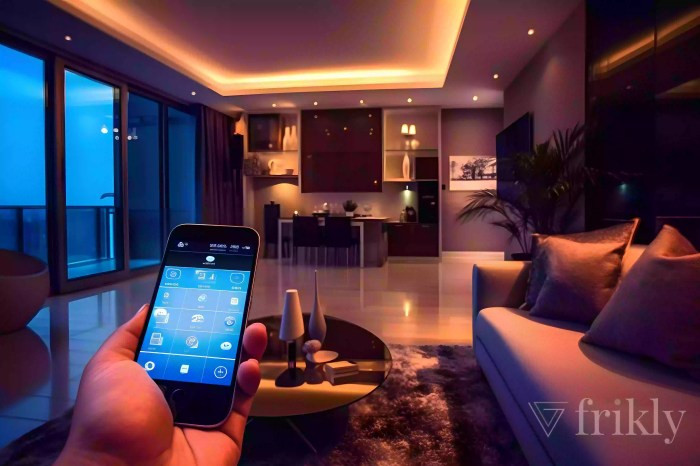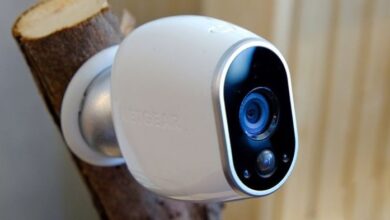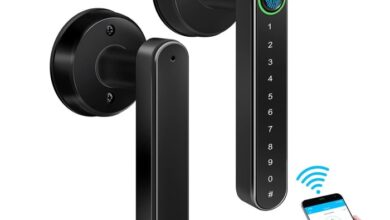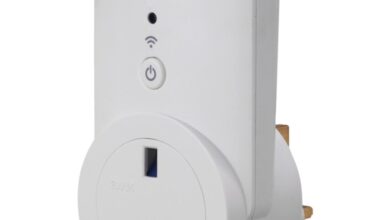Smart Lighting Illuminating the Future
Smart Lighting: Imagine a world where your lights anticipate your needs, adjusting brightness and color to perfectly match your mood and daily rhythm. It’s not science fiction; it’s the reality of smart lighting technology, a rapidly evolving field poised to revolutionize how we interact with our environments, from homes and offices to entire cities. This deep dive explores the innovative technologies, diverse applications, and future potential of smart lighting, revealing how it’s more than just a convenient upgrade – it’s a transformative force shaping the way we live and work.
From energy-efficient LEDs and the intricacies of communication protocols like Zigbee and Z-Wave to seamless integration with smart home ecosystems and the potential of AI-driven automation, we’ll unravel the complexities and explore the limitless possibilities of smart lighting. We’ll examine how smart lighting enhances safety, improves productivity, and contributes to a healthier, more sustainable future. Prepare to be illuminated!
Smart Lighting Technologies
The smart home revolution has significantly impacted lighting, transforming it from a simple utility into a customizable and energy-efficient element controlled by your smartphone or voice assistant. This shift has been driven by advancements in LED technology, improved communication protocols, and the growing demand for home automation. Understanding the different technologies available is crucial for making informed decisions when upgrading your home lighting.
Types of Smart Lighting Technologies
The market offers a diverse range of smart lighting options, each with its own strengths and weaknesses. The key differentiators often lie in the light source itself (LED, incandescent, fluorescent) and the communication protocol used to control it.
Comparison of Smart Lighting Options
LED, incandescent, and fluorescent technologies all have smart versions, but their energy efficiency and lifespan differ considerably. LED smart bulbs are generally the most energy-efficient and long-lasting, boasting significantly lower energy consumption and a much longer lifespan compared to incandescent or fluorescent counterparts. Incandescent bulbs, while readily available and relatively inexpensive upfront, are notoriously energy-inefficient and have a short lifespan.
Fluorescent smart bulbs offer a middle ground, being more energy-efficient than incandescent but less so than LEDs, with a lifespan falling between the two. The long-term cost savings associated with LEDs, considering their lower energy consumption and extended lifespan, often outweigh their higher initial purchase price. For example, a high-quality LED smart bulb might cost twice as much initially but last ten times longer and consume significantly less energy, leading to substantial savings over its lifetime.
Smart Lighting Communication Protocols
Various communication protocols enable the seamless integration of smart lighting into your home network. Each protocol offers a unique balance of range, power consumption, security, and cost. Choosing the right protocol depends on your specific needs and existing home network infrastructure.
| Protocol | Range | Power Consumption | Security | Cost |
|---|---|---|---|---|
| Zigbee | Up to 100 meters (depending on obstacles) | Low | Good (encryption available) | Moderate |
| Z-Wave | Up to 30 meters (depending on obstacles) | Low | Excellent (strong encryption) | High |
| Bluetooth | Up to 10 meters | Low | Moderate | Low |
| Wi-Fi | Dependent on router range | Moderate | Moderate (depends on router security) | Low to Moderate |
Choosing the right protocol involves weighing the trade-offs between range, power efficiency, security features, and cost. For instance, while Wi-Fi offers broad coverage, its higher power consumption might not be ideal for numerous devices. Conversely, Zigbee provides a good balance between range and power consumption.
Smart Lighting Applications and Use Cases
Smart lighting transcends simple illumination; it’s a dynamic technology reshaping how we interact with our environments, from homes to industrial complexes. Its versatility allows for tailored solutions addressing diverse needs, enhancing efficiency, security, and overall user experience. This section explores the multifaceted applications and use cases of smart lighting across various sectors.
Residential Smart Lighting Implementations
Smart lighting offers homeowners unparalleled control and convenience. The ability to automate, personalize, and remotely manage lighting systems significantly improves daily life. Consider these key residential applications:
- Automated Scene Setting: Imagine instantly transforming your living room from a bright workspace to a cozy movie night atmosphere with a single tap on your smartphone. Smart lighting allows for pre-programmed “scenes” that adjust brightness, color temperature, and even individual light fixtures to match specific moods or activities.
- Energy-Efficient Scheduling: Smart bulbs and systems can be programmed to automatically turn off lights in unoccupied rooms or adjust brightness based on natural light levels. This significantly reduces energy consumption and lowers electricity bills. For example, a system could automatically dim lights in the evening or turn them off completely when no motion is detected.
- Enhanced Security Features: Smart lighting can simulate occupancy even when the home is empty, deterring potential intruders. Systems can be programmed to randomly switch lights on and off, creating the illusion of someone being home. This feature is particularly effective when combined with smart security systems.
- Personalized Wake-Up Lights: Gradually increasing light intensity in the morning can mimic a natural sunrise, promoting a more gentle and refreshing wake-up experience. This is far more pleasant than a jarring alarm clock and can positively impact circadian rhythms.
- Remote Control and Monitoring: From anywhere with an internet connection, homeowners can control their lights, check their status, and even adjust settings remotely. This provides convenience and peace of mind, especially when away from home.
Commercial Smart Lighting Benefits
In commercial settings, the advantages of smart lighting extend beyond convenience. They translate into significant cost savings and improved operational efficiency.Energy savings are a primary driver. Smart lighting systems use sensors and automation to optimize energy use, reducing overall consumption by strategically adjusting lighting levels based on occupancy and ambient light. This translates directly into lower energy bills and a smaller carbon footprint.
For example, a retail store can significantly reduce energy waste by automatically dimming lights during off-peak hours or in areas with sufficient natural light.Ambiance control is another key benefit. Smart lighting allows businesses to create the perfect atmosphere for their specific needs. Retail stores can use dynamic lighting to highlight products and create visually appealing displays. Offices can adjust lighting levels and color temperatures to enhance productivity and employee well-being, creating a more stimulating or calming environment depending on the task.Security is further enhanced with smart lighting.
Motion sensors can automatically illuminate areas when movement is detected, deterring potential intruders and improving safety for employees and customers. This feature is particularly valuable in parking lots, warehouses, or other areas prone to security concerns. Consider a large office complex: smart lighting can automatically illuminate stairwells and hallways at night, ensuring safe passage for employees working late.
Industrial Smart Lighting: Safety and Efficiency
Smart lighting plays a critical role in industrial environments, prioritizing safety and efficiency improvements. In manufacturing plants and warehouses, strategically placed smart lights enhance visibility and reduce workplace accidents. Motion sensors can illuminate work areas only when needed, preventing falls and collisions in low-light conditions. Furthermore, smart lighting systems can be integrated with other industrial IoT devices, providing real-time data on energy consumption and equipment status.
This data-driven approach allows for proactive maintenance, reducing downtime and improving overall operational efficiency. For example, a manufacturing plant can monitor the energy consumption of each lighting zone and identify areas for optimization, reducing costs and improving sustainability. Moreover, predictive maintenance alerts based on lighting system data can prevent unexpected failures, minimizing disruption to production.
Smart Lighting Control and Integration

Smart lighting isn’t just about switching lights on and off; it’s about seamlessly weaving illumination into the fabric of your smart home ecosystem. This level of integration unlocks a world of convenience, automation, and personalized experiences, transforming your home from a static environment into a dynamic, responsive space. The ability to control your lighting through various platforms and devices significantly enhances the overall smart home experience, offering a level of control previously unimaginable.Smart lighting systems achieve this seamless integration through various protocols and APIs.
They often connect to other smart home devices and platforms like Amazon Alexa, Google Home, Apple HomeKit, and Samsung SmartThings using established communication standards such as Zigbee, Z-Wave, Wi-Fi, and Bluetooth. This interoperability allows users to control their lights via voice commands, mobile apps, or even through automated routines triggered by other smart home sensors. For example, your lights could automatically dim at sunset, brighten when a motion sensor detects movement, or change color based on your preferred mood setting.
This level of interconnectedness elevates the smart home from a collection of individual devices to a truly integrated system.
Smart Lighting App User Interface Design
A well-designed smart lighting app is crucial for maximizing the user experience. A clean, intuitive interface is paramount, allowing users to easily manage their lighting setups without frustration. The app should prioritize ease of use and accessibility, making it simple to create scenes, schedules, and customize individual light settings.The key features and functionalities of such an app should include:
- Individual Light Control: The ability to turn individual lights on/off, adjust brightness, and change color temperature (warm to cool white) or color (RGB). This granular control allows for precise customization of lighting in each room.
- Scene Creation and Management: Users should be able to create and save lighting scenes (e.g., “Movie Night,” “Relaxing Evening,” “Party Mode”) that automatically adjust the brightness, color, and settings of multiple lights simultaneously.
- Automated Scheduling: The app should allow users to create schedules for lights to turn on and off at specific times, mimicking natural sunlight patterns or personal preferences. This can also be geo-fenced, turning lights on when you approach home and off when you leave.
- Group Control: The ability to group lights together (e.g., all lights on the first floor) for easy control and scene creation. This simplifies management for larger homes with numerous lighting fixtures.
- Integration with Voice Assistants: Seamless integration with popular voice assistants (Alexa, Google Assistant) allows for hands-free control of lights through simple voice commands.
- Integration with other Smart Home Platforms: The app should integrate with other smart home platforms, allowing for automation based on triggers from other devices (e.g., turning lights on when a door sensor detects entry).
- Remote Access and Control: The ability to control lights remotely via the app, regardless of location. This is particularly useful for security and convenience.
Automated Lighting Schedules and Scenes
Creating automated lighting schedules and scenes is a cornerstone of the smart lighting experience. Different platforms offer various methods to achieve this, often through intuitive interfaces within their respective apps. For example, in a system like Philips Hue, users can set timers for lights to turn on and off at specific times, creating a simulated sunrise/sunset effect. They can also create scenes with pre-set lighting configurations, instantly transforming the ambiance of a room with a simple tap.
In other platforms like LIFX, users can leverage advanced features like geofencing to automate lighting based on location, while platforms like Lutron offer more sophisticated control over lighting intensity and dimming curves. The implementation of these features varies across platforms, but the fundamental goal remains consistent: to offer effortless control and automation.
Creating effective automated lighting not only enhances convenience but also contributes to energy savings and improved home security.
Smart Lighting and Energy Efficiency
Smart lighting systems offer a compelling pathway to significant energy savings, going far beyond the capabilities of traditional lighting solutions. By leveraging advanced technologies like sensors, automation, and intelligent controls, these systems optimize energy consumption in ways previously unimaginable, leading to both financial and environmental benefits. This section explores how smart lighting achieves these savings and examines the challenges in maximizing its energy-efficiency potential.Smart lighting’s energy efficiency stems from its ability to precisely tailor lighting to real-time needs.
Unlike traditional systems, which often remain on regardless of occupancy or ambient light levels, smart lighting adapts dynamically. This responsiveness minimizes wasted energy, translating directly into lower electricity bills and a reduced carbon footprint. Furthermore, the integration of smart lighting with other smart home devices allows for even more refined control and optimization, creating a truly interconnected and energy-conscious environment.
Methods for Optimizing Energy Consumption with Smart Lighting Systems
Several strategies significantly enhance the energy efficiency of smart lighting installations. Scheduling allows lights to turn on and off automatically based on pre-programmed times, eliminating the need for manual control and preventing lights from being left on unnecessarily. Occupancy sensors detect the presence or absence of people in a room, automatically switching lights on only when needed and off when the space is unoccupied.
Daylight harvesting leverages natural light, reducing or eliminating the need for artificial lighting during daylight hours. Finally, dimming capabilities allow for adjusting light intensity to match the required level, further conserving energy. The combined effect of these methods can dramatically reduce energy consumption.
Comparison of Energy Savings: Smart vs. Traditional Lighting, Smart Lighting
The following table compares the energy usage and cost savings achievable with smart lighting versus traditional lighting in various scenarios. These figures are illustrative and can vary depending on factors like fixture type, usage patterns, and energy costs. However, they highlight the potential for substantial energy savings.
| Lighting Type | Energy Usage (kWh/year) | Estimated Cost Savings (USD/year) | Scenario |
|---|---|---|---|
| Traditional Incandescent | 1500 | $0 | Office with always-on lighting |
| Smart LED with Scheduling & Occupancy Sensors | 300 | $120 | Same office, optimized smart lighting |
| Traditional Fluorescent | 800 | $0 | Home with infrequent use |
| Smart LED with Dimming & Daylight Harvesting | 200 | $60 | Same home, optimized smart lighting |
Challenges and Limitations in Achieving Maximum Energy Efficiency
While smart lighting offers significant energy-saving potential, several factors can hinder the achievement of maximum efficiency. Initial investment costs can be higher than traditional lighting systems, potentially offsetting some of the long-term savings. Incorrect installation or configuration can lead to suboptimal performance, negating the intended energy benefits. Furthermore, reliance on network connectivity and smart home hubs introduces potential points of failure, which can disrupt the system’s operation and impact energy savings.
Finally, the effectiveness of energy-saving features like occupancy sensors can be affected by factors such as environmental conditions and sensor placement. Careful planning, proper installation, and ongoing maintenance are crucial to maximizing the energy efficiency of smart lighting systems.
Future Trends in Smart Lighting
The smart lighting landscape is rapidly evolving, driven by advancements in artificial intelligence, sensor technology, and user expectations. We’re moving beyond simple on/off controls and into a future where lighting systems anticipate our needs, optimize energy consumption, and even enhance our well-being. This shift is fueled by the integration of sophisticated algorithms and the increasing availability of affordable, powerful hardware.The potential for AI and machine learning to transform smart lighting is immense.
These technologies are no longer a futuristic concept; they are actively shaping the market, offering features that were once considered science fiction.
AI and Machine Learning in Smart Lighting
AI and machine learning are poised to revolutionize smart lighting by enabling systems to learn user preferences, optimize energy usage, and proactively address potential issues. For instance, AI-powered systems can analyze occupancy patterns to automatically adjust lighting levels, saving energy while ensuring optimal illumination. Machine learning algorithms can predict potential equipment failures, allowing for proactive maintenance and minimizing downtime.
This predictive maintenance capability is particularly valuable in large-scale installations like commercial buildings or smart cities, where unscheduled outages can be costly and disruptive. Consider the example of a large office complex: an AI-powered system could learn the typical occupancy patterns of different floors and rooms throughout the day and automatically adjust lighting levels accordingly, resulting in significant energy savings.
Furthermore, by analyzing historical data on lighting fixture performance, the system can anticipate potential failures and schedule maintenance before they occur, minimizing disruptions to operations.
Innovative Smart Lighting Applications
Several innovative applications are emerging, showcasing the versatility and potential of smart lighting beyond simple illumination. Human-centric lighting (HCL) systems adjust color temperature and intensity to mimic natural daylight, promoting better sleep, mood, and productivity. Imagine a smart home system that automatically adjusts the lighting throughout the day to align with the natural circadian rhythm, creating a more comfortable and energizing environment.
Another area of rapid growth is the integration of smart lighting with other smart home devices. This allows for seamless control and automation, enhancing security and convenience. For example, smart lighting can be integrated with security systems to automatically illuminate areas when motion is detected, acting as a deterrent to potential intruders. Similarly, it can be linked to other smart home devices to create automated scenes, such as setting the mood for a movie night or creating a relaxing atmosphere before bedtime.
Beyond homes, smart lighting is being integrated into public spaces to improve safety and wayfinding.
A Futuristic Smart Lighting System
Imagine a futuristic smart lighting system that seamlessly blends into the architecture of a building. The system is comprised of thousands of individually addressable LED lights embedded within the walls and ceilings, appearing as a continuous, glowing surface. The lighting dynamically adjusts based on occupancy, natural light levels, and even the time of day, creating a personalized and adaptive environment.
The system utilizes advanced sensors to monitor environmental conditions such as temperature and humidity, adjusting lighting levels to optimize comfort and energy efficiency. The interface is intuitive and user-friendly, allowing for easy customization of lighting scenes and schedules through a smartphone app or voice control. This system is not just about illumination; it’s a holistic environmental management system that contributes to a healthier, more productive, and sustainable built environment.
Its key features include AI-driven automation, seamless integration with other smart home technologies, and energy-saving capabilities. The benefits include improved energy efficiency, enhanced comfort and well-being, and increased security. This futuristic system represents a paradigm shift, moving beyond simply providing light to actively shaping the environment for the benefit of its occupants.
Smart Lighting and Human-centric Design
Smart lighting isn’t just about energy efficiency and automation; it’s about creating environments that support and enhance human well-being. A human-centric approach to smart lighting prioritizes the impact of light on our mood, sleep patterns, productivity, and overall health. By carefully considering these factors during design and implementation, we can harness the power of light to create truly beneficial and comfortable spaces.
This shift towards a more holistic understanding of light’s influence is crucial for maximizing the potential of smart lighting technology.Smart lighting systems offer a powerful tool for improving human well-being through precise control over light intensity, color temperature, and even light patterns. These systems allow for personalized lighting environments tailored to individual needs and preferences, creating a positive impact on various aspects of daily life.
For example, strategically implemented smart lighting can significantly improve focus during work hours, promote restful sleep at night, and even elevate mood throughout the day. The ability to seamlessly adjust these lighting parameters based on time of day, activity, or even individual preferences represents a significant advancement in how we interact with our environment.
Impact of Color Temperature and Light Levels on Human Health and Productivity
The color temperature of light, measured in Kelvin (K), significantly influences our circadian rhythm and mood. Cooler light (higher Kelvin values, like 5000K-6500K) resembles daylight and promotes alertness and focus, making it ideal for workspaces or areas requiring high concentration. Warmer light (lower Kelvin values, like 2700K-3000K) is more relaxing and conducive to sleep, suitable for bedrooms or evening settings.
Similarly, light intensity, measured in lumens, impacts our alertness and productivity. Brighter light generally improves alertness, while dimmer light promotes relaxation. A well-designed smart lighting system would dynamically adjust both color temperature and intensity throughout the day to optimize these effects. For instance, a smart office might gradually shift from cool, bright light in the morning to a warmer, softer light in the afternoon to prevent eye strain and maintain productivity throughout the workday.
This adaptive lighting approach, mirroring the natural changes in daylight, minimizes disruption to our internal clocks and supports a more natural and healthy rhythm.
Enhancing Mood and Promoting Sleep Through Smart Lighting
Studies show a strong correlation between light exposure and mood regulation. Smart lighting systems can be programmed to mimic natural daylight cycles, helping to regulate melatonin production and improve sleep quality. For example, gradually dimming the lights in the evening with a shift towards warmer color temperatures can signal the body to prepare for sleep, promoting a more restful night’s rest.
Conversely, exposure to brighter, cooler light in the morning can help suppress melatonin and promote wakefulness. Furthermore, strategically placed smart lights can create a more inviting and pleasant atmosphere, improving mood and reducing stress. Think of a home setting where a warm, soft glow welcomes you at the end of a long day, instantly creating a more relaxed environment.
This type of personalized lighting experience, tailored to the time of day and individual preferences, significantly impacts our emotional well-being and sleep cycles. Research indicates that consistent exposure to bright light during the day and darkness at night is crucial for maintaining a healthy circadian rhythm, and smart lighting technology makes this easier than ever before.
Improving Focus and Productivity with Smart Lighting
The right lighting can significantly enhance focus and productivity. Smart lighting systems allow for the creation of customized lighting scenarios optimized for different tasks. For example, a bright, cool-toned light setting can be ideal for focused work, while a softer, warmer light might be more appropriate for brainstorming or collaborative tasks. The ability to easily switch between these scenarios, or even gradually adjust the lighting throughout the day, prevents eye strain and promotes sustained concentration.
Moreover, smart lighting can be integrated with other productivity tools, such as calendars or task management apps, to automatically adjust lighting based on scheduled events or tasks. Imagine a scenario where your smart lighting system automatically shifts to a focused work setting when you begin a video conference or start working on an important project. This seamless integration of lighting with other aspects of our daily routines further enhances productivity and overall efficiency.
Ending Remarks
Smart lighting is no longer a futuristic concept; it’s a practical and powerful tool reshaping our world. Its ability to optimize energy consumption, enhance ambiance, and improve safety and well-being makes it an essential element of modern living and a key driver of sustainable development. As technology continues to advance, the possibilities for smart lighting are endless, promising a future where light is not just illumination, but a dynamic and responsive element of our daily lives, seamlessly integrated into a smarter, more efficient, and more human-centric world.
The journey into this intelligent illumination has only just begun.









